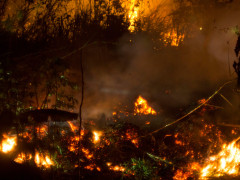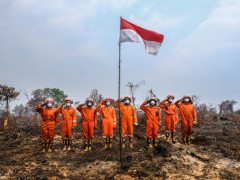Land Fire Surge 2025: Hot Weather Narrative Masks Government and Corporate Accountability
By AdminAlert! The Looming Threat of Haze Amidst the Pandemic
Just like in previous years, mass media headlines will soon be dominated by news of land and forest fires in regions where the disaster typically strikes. The Meteorology, Climatology and Geophysics Agency (BMKG) estimates that the dry season will arrive in June and peak in August. This year, however, the threat of land and forest fires, and the haze caused by the fires, loom in the midst of the COVID-19 pandemic. As both the pandemic and the land and forest fires pose severe risks to our respiratory system, how will the government address the two national disasters?
As recently as August 2019, Jakarta was declared the worst polluted city in the world, with a PM2.5 level of 92.4 μg/m3 and PM10 of 53.5 μg/m3. PM2.5 and PM10 are two indicators to measure the level of air pollution.
Areas hit with land and forest fires are certain to experience increased PM10 and PM2.5 levels, which will likely be even higher than Jakarta’s worst conditions in 2019. According to a study by the National Nuclear Energy Agency (BATAN), the PM2.5 and PM10 levels during the 2015 forest and land fires in Pekanbaru reached 108 μg/m3 and 55 μg/m3, respectively. In addition, the fires emit other toxic gases, further worsening the quality of life of local communities.
In the midst of the COVID-19 pandemic, smoke from land and forest fires will no doubt exacerbate the condition of COVID-19 patients and people with weak immune systems. A study by Xiao, et.al. of Harvard shows COVID-19 deaths will likely increase by 8% when long-term exposure to PM2.5 increases every 1 micron.
If the Xiao study is used in the Indonesian context, this means that people who live in areas that have been exposed to PM2.5 for years, i.e., regions affected by land and forest fires, have a higher risk of dying from COVID-19 compared to those living in areas with better air quality.
PM2.5 particles accumulate inside the human body for years, thereby lowering the body’s resistance to viruses that attack the respiratory tract such as COVID-19. This can be exacerbated by the lack of adequate N-95 masks, since PM2.5 can penetrate anything less than the N-95 masks.
Unfortunately, the Ministry of Environment and Forestry (KLHK) has never released official historical data of PM2.5 measurements in various land and forest fire-prone areas. As a result, the increase in PM2.5 over the last few years cannot be ascertained. Currently, we can only see the history of PM10 pollution during forest and land fires based on KLHK data archives.
According to the archives, in 2019 PM10 pollution levels in the cities of Pekanbaru, Jambi, and Palangka Raya were in the “Very Dangerous” category (>400 μg/m3). This figure far exceeds the threshold allowed by the Indonesian government or the WHO.
A fire equivalent to 24 times the total land area of Jakarta likely to repeat this year
Still affected by the consequences of last year’s land and forest fires, people in Sumatra and Kalimantan are likely to face yet another iteration of the disaster soon. For these people, land and forest fires have been a nightmare that repeats itself every year. This time around, however, they are also battling with the COVID-19 pandemic on top of the fires and the haze.
In 2019, the fires scorched 1.6 million hectares of forest in Indonesia, of which 31% of the total burned area is on peatlands. From a total of 14.9 million peat areas in Indonesia, Pantau Gambut also identified a pattern of repeated peat fires in most of the protected peat areas throughout 2015-2019, areas that should have been protected from any disturbance.
On the other hand, the status of law enforcement in cases of forest and land fires is still unclear. Although many of the burnt areas have been sealed by the authorities, the investigation process has been slow and lacks transparency, causing many questions and legal uncertainty.
Indecision towards the perpetrators of land arson will likely cause even more victims, especially now that the COVID-19 pandemic is still ongoing. If the Indonesian government is already starting to get overwhelmed in the face of the pandemic, imagine what happens when the land and forest fires take place.
Which areas of Indonesia are vulnerable to being affected by forest fires and COVID-19 at the same time?
Responding to the threat of forest and land fires in the midst of the COVID-19 pandemic, Pantau Gambut conducted an analysis of the vulnerability of peat areas to forest and land fires combined with a map of COVID-19 risk level in Indonesia. This analysis aims to identify areas that are potentially affected by forest and land fires and COVID-19 at the same time.
Pantau Gambut found that a region’s vulnerability to forest and land fires came from a combination of several factors, namely:
- land cover,
- peat distribution, and
- slope level.
Spatial analysis of these three factors was then verified with data on the distribution of hot spots and burned land during the 2016-2019 period.
As for the parameters of the region’s vulnerability to COVID-19, Pantau Gambut considers:
- hazard (distribution of positive COVID-19 cases),
- vulnerability (distribution of population density) and
- capacity (distribution of hospitals)
Based on the two analyses, Pantau Gambut concludes that the majority of peatlands in Sumatra and Kalimantan are once again classified as “Vulnerable” to “Very Vulnerable” to fire.
If we refer to 2017 BPS data, this means that around 470 thousand people living on peatlands in Jambi, and 2.5 million people living on peatlands in Riau, are facing extreme threats and should be on high alert. These two provinces have a very high threat of forest and land fires, and a moderate to high COVID-19 risk range, so people must be extra careful.
Meanwhile, other provinces on the islands of Sumatra and Kalimantan that have peatlands are at very low to moderate risk of COVID-19. A different result appears for peatlands in the provinces of Papua and West Papua. Although most of the peatlands in these two provinces are classified as less vulnerable to forest and land fires, the threat to COVID-19 is in the moderate category. This means that the Papuan people must also remain vigilant.
Readiness in the face of two national disasters
The twin threats discussed earlier will be a major blow to any unprepared government. Haze can disrupt daily activities, worsen the health of COVID-19 patients, and even contribute to air pollution for neighboring countries who are also struggling with COVID-19.
So far, the government has indeed made various efforts to reduce the impact of forest and land fires, including by monitoring hot spots and air quality, activities that are still being carried out in the field by observing COVID-19 health protocols. Air patrols and water bombing activities have also been carried out in Riau Province, where nine helicopters have been dispatched to sprinkle more than 11 million liters of water on peatlands and to fill existing canals or water reservoirs.
The Ministry of Environment and Forestry, together with the Agency for the Assessment and Application of Technology (BPPT), also continued to carry out Weather Modification Technology (TMC) prior to the decline in rainfall in June. Artificial rain activities are prioritized in provinces that are very prone to forest and land fires, such as Riau, Jambi, and South Sumatra. To this day, the government has sprinkled more than 21 tons of salt, producing a total volume of 97.8 million m3 of rain almost every day. KLHK has also coordinated with 15 governors and 31 district heads and mayors to encourage peatland rewetting to prevent forest and land fires.
However, these efforts are still inadequate to reduce the impact of the two disasters because no strategic scenario has been prepared in the health sector when the haze disaster arrives. Pantau Gambut sees that hospital capacity to handle the COVID-19 pandemic in fire-prone provinces (Riau, Jambi, South Sumatra, West Kalimantan, Central Kalimantan, South Kalimantan and Papua) is still far from sufficient. Assuming that 30% of the 5,619 positive cases of COVID-19 in 7 provinces prone to forest and land fires require intensive treatment in hospitals, the government would have to prepare 1,686 bed units for COVID-19 intensive care. Currently, there are only 864 intensive care unit (ICU) beds available in these provinces combined, and these beds still need to be shared with non-COVID-19 patients.
In terms of logistics, the government must also fulfill the need for Personal Protective Equipment (PPE). Assuming that medical workers need a minimum of 15 sets of PPE per day to treat every patient (with each set of PPE consisting of N95 masks, goggles/face shields, special waterproof clothing, and medical gloves), the total number of PPE sets needed to treat 5,619 intensive care patients for a minimum of 8 days is 674,280. At the same time, people living in areas affected by forest and land fires also need N95 masks to dispel toxic particles.
Based on lessons learned from previous years, the government must ensure that local residents do not continue to breathe in the suffocating toxic air that can cause fatalities. The government’s lack of preparedness and the absence of strategic steps both in the short and long term are predicted to cause premature deaths in up to 36 thousand people per year in all affected areas during the 2020-2030 period.
To address this threat, Pantau Gambut requests the government at the central and regional levels to immediately put an end to the annual forest fire disaster by preventing the emergence of hot spots, addressing forest and land fires effectively, as well as enforcing firm punishment and demanding penalties for the perpetrators of forest fires. Furthermore, considering various potential limitations in the health sector, the government must also determine and implement strategic steps in handling those affected by forest and land fires and infected with COVID-19.

_.gif)



